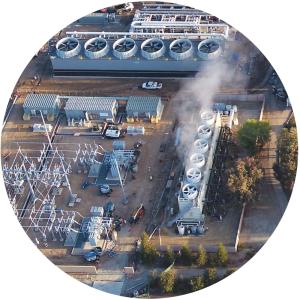At Lawrence Livermore National Laboratory (LLNL), we pursue mission-directed science and technology (S&T) with a keen eye on the future.
FY 2021 was a transformational year for our Laboratory and the world. The ongoing COVID-19 pandemic and a rapidly changing security environment demonstrated the importance of looking over the horizon and anticipating an uncertain future. These challenges have also demonstrated the power of S&T to bring forward innovative solutions and strategies to make the world a safer place. This Annual Report describes Livermore’s advances at the frontiers of S&T, as exemplified by the “shot heard round the world” at the National Ignition Facility (NIF). We translate our innovations into meaningful products with impact, often in partnership with others, to strengthen national security in an increasingly dynamic world.
LLNL provides unique expertise and world-class scientific tools in support of national security with a core mission to sustain and advance nuclear deterrence. We are an essential part of the Department of Energy (DOE) national laboratory system and the National Nuclear Security Administration (NNSA) nuclear security enterprise. Our Laboratory is fully engaged in programs to modernize the nation’s nuclear weapons stockpile and enterprise—developing and implementing innovations in design, engineering, and manufacturing in partnership with other laboratories, plants, sites, and federal stakeholders. We are striving to make the nuclear security enterprise agile, resilient, sustainable, and responsive to emerging national needs. As a national security laboratory, LLNL is chartered to apply our special scientific and engineering tools and competencies to address four strategic mission priorities.
Strategic Mission Priorities
Nuclear Deterrence continues to be the defining responsibility of our Laboratory. We must assure the safety, security, and effectiveness of the U.S. nuclear stockpile in an evolving security environment. This mission drives major investments at Livermore, shapes our S&T strengths, and demands that we deliver on aggressive timelines. As highlighted in our Annual Report, we are delivering the first two modernized warheads of the stockpile stewardship era: the W80-4 warhead—to be carried on the all-new Long-Range Standoff missile—and the W87-1 warhead for the future Ground Based Strategic Deterrent system. These programs will modernize the warheads—improving safety, introducing new materials and components, and assuring robust performance—as well as the production enterprise. Through close partnerships with the production sites, called enclaves, we are developing and introducing advanced manufacturing technologies, development approaches, and business processes to improve efficiencies, lower costs, and provide greater agility in responding to emerging needs. We are also pursuing major advances in computing hardware and simulation, experimental capabilities, and diagnostics to provide critical support for weapons design and certification as well as enterprise transformation.
Threat Preparedness and Response is required to counter natural and human-made threats, prevent the use of weapons of mass destruction (WMD), and enhance global security. In support of Livermore’s broader national security mission and NNSA’s nuclear nonproliferation responsibilities, the Laboratory is a source of unique capabilities and expertise to anticipate threats and provide innovative solutions. We support the intelligence community, develop and apply cutting-edge forensic science to WMD attribution, and advance nuclear nonproliferation objectives. Our Annual Report highlights LLNL’s leadership in biosecurity S&T, which began in the 1990s with the development of bioagent detectors in anticipation of the threat. In FY 2021, Livermore applied innovative high-performance computing tools and laboratory analyses in response to the COVID-19 pandemic, developed the first nerve-agent antidote effective in protecting the central and peripheral nervous systems, and engaged in partnerships to develop a universal vaccine.
Climate and Energy Resilience is one of today’s most pressing challenges and national security concerns. LLNL has been a leader in understanding the climate since the 1950s when the first climate model simulating large weather systems ran on Laboratory supercomputers. In FY 2021, high-resolution climate models were used to understand the regional effects of climate change, a critical step toward developing mitigation strategies and preparing communities to adapt. Groundbreaking reports issued by LLNL evaluated technologies that can lead California to carbon neutrality by 2045 and examined the challenges facing implementation of carbon-capture technologies. Our Annual Report also features the application of additive manufacturing to create efficient reactors for recycling captured carbon into useful industrial products.
Integrated Deterrence and Competition seeks to create strategic advantages in an increasingly dynamic and dangerous multipolar world. LLNL’s Center for Global Security Research serves the policy community as a “thought leader” about integrated deterrence to meet multifaceted challenges: WMD, cyber and space security, directed energy systems, and hypersonic conventional weapons. Livermore is focused on understanding the potential threats and developing advanced defense technologies and scenario modeling tools. Moreover, S&T leadership is paramount to strategic competition. NIF experiments at the threshold of ignition, preparation for delivery of the exascale El Capitan supercomputer, and advancement of cognitive simulation—integrating high-performance computing, big data, S&T simulations, and artificial intelligence—exemplify areas of LLNL leadership.
Transforming the Laboratory
Livermore is changing—with new facilities, new staff, and a new mode of operation all focused on the future and our 21st-century mission priorities. Our Annual Report features major construction projects that contribute to revitalizing the Laboratory’s infrastructure and S&T research capabilities. During the COVID-19 pandemic, LLNL continued to operate with measures to ensure worker health and safety and launched the process of a “Return to New Normal.” Telework and hybrid work schedules are now part of everyday operations, and our use of video teleconferencing technology continues to advance. This added flexibility enables individuals to attain a better work–life balance and the Laboratory to operate under changing conditions. Outstanding people are the Laboratory’s most important resource, and we continue to recruit the very best to join our team. Our culture is adapting to the generational change, building on and advancing the heritage established by Livermore’s founders. We thrive on serving as a “new ideas” laboratory, pursuing multidisciplinary “big science” in the national interest.








